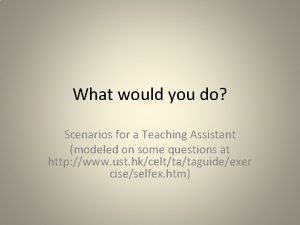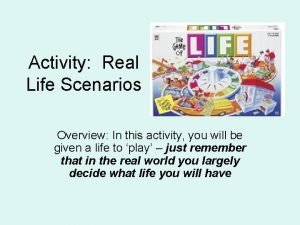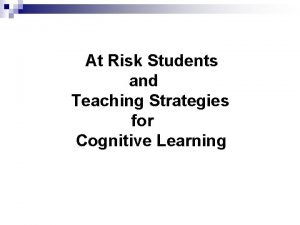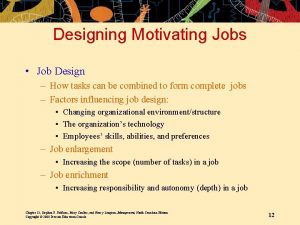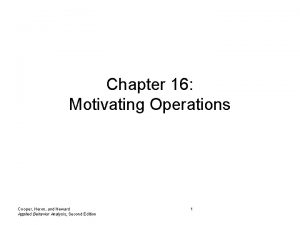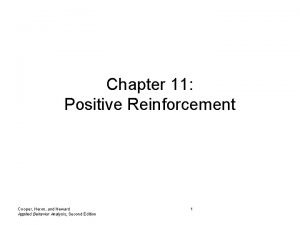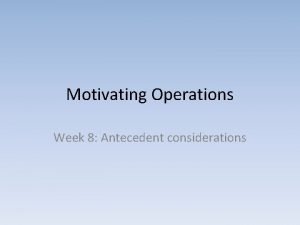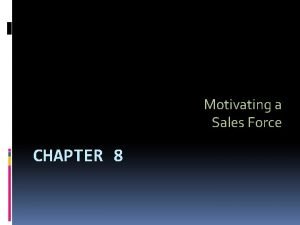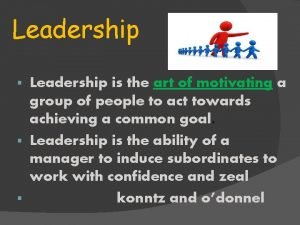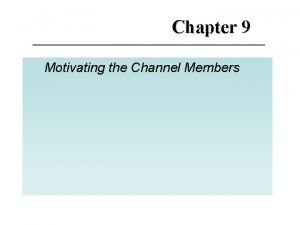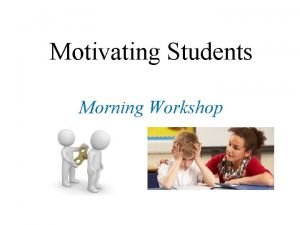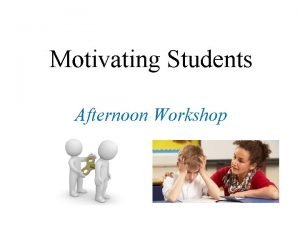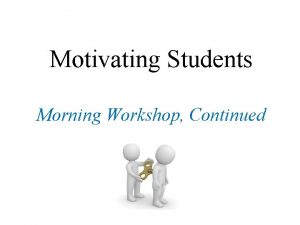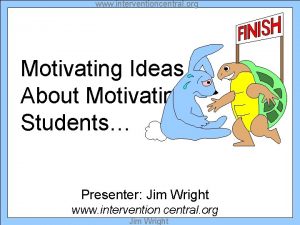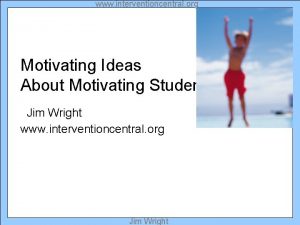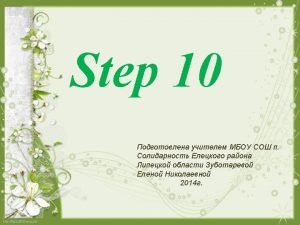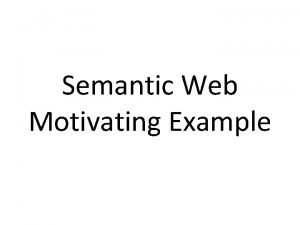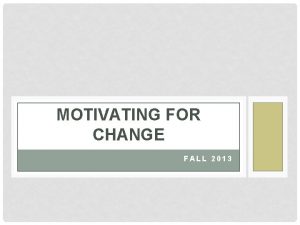Motivating Students Morning Workshop Warmup Activity Teaching Scenarios

























































- Slides: 57

Motivating Students Morning Workshop

Warm-up Activity

Teaching Scenarios Activity Consider your extent of personal endorsement of Scenarios #1 & #2. Consider your extent of agreement vs. disagreement with each approach: “This is an accurate and true description of what I do during my teaching. ”

Purpose of Today’s Workshop We will be together all day—and into tomorrow if you find this helpful. Throughout all these hours, we pursue one single overall goal or purpose: A Meaningfully Upgraded, High-Quality Motivating Style toward Students Your Currently Existing Motivating Style toward Students An Expanded Motivating Style toward Students (New Instructional Behaviors, New Instructional Goals)

Purpose of Today’s Workshop We will be together all day—and into tomorrow if you find this helpful. Throughout all these hours, we pursue one single overall goal or purpose: • • A Meaningfully Upgraded, High-Quality Motivating Style toward Students (Effective, easy-to-do, and evidence based) Your Currently Existing Motivating Style toward Students An Expanded Motivating Style toward Students (New Instructional Behaviors, New Instructional Goals) Personal Development Skill Development Personal Growth Relationship Growth (with your students)

Plan Morning • What Autonomy Support Is • Adopting an Autonomy-Supportive Mindset Afternoon • Developing the Skill to Become More Autonomy Supportive • Discussion: Dr. Elena Marin and Dr. Simona Iftimescu Tomorrow • Autonomy Support + Competence Support • Explain Exactly How this Is Supposed to Work (Mechanisms of Change) • Interesting Questions

An Ineffective vs. Effective Teacher Response to… Student Misbehavior (Texting in class) Consider first a common, but highly ineffective, instructional strategy… Consider now a less common, but highly effective, instructional strategy…

An Ineffective vs. Effective Teacher Response to… Students Need to Put Forth Greater Effort Consider first a common, but highly ineffective, instructional strategy… Consider now a less common, but highly effective, instructional strategy…

An Ineffective vs. Effective Teacher Response to… Poor Performance Consider first a common, but highly ineffective, instructional strategy… Consider now a less common, but highly effective, instructional strategy…

A Teacher’s Motivating Style How to Support Students’ Classroom Motivation and Engagement

Motivating Style • What teachers say and do during instruction to motivate their students to engage in learning activities. Autonomy-Supportive Teacher identifies, appreciates, vitalizes. and supports students’ inner motivational resources during instruction. Teaching Scenario #2 Neutral Teacher ignores, neglects, and by-passes students’ inner motivational resources during instruction. Controlling Teacher frustrates and thwarts students’ inner motivational resources during instruction. (Teacher prescribes and pressures for compliance). Teaching Scenario #1

Motivating Style • What teachers say and do during instruction to motivate their students to engage in learning activities. Autonomy-Supportive Neutral Controlling Teacher’s Tone during Student-Teacher Interactions: • I am your ally. • I will help you. • I am here to understand support you and your strivings. • I am your boss. • I will monitor you. • I am here to socialize and change you.

The Interpersonal Tone that Becomes the Teacher’s Motivating Style Autonomy Support Teacher Control Tone: UNDERSTANDING Tone: PRESSURE “I am your ally. I am here to support you and your strivings. ” “I am your boss. I am here to socialize and to change you. ” Perspective Taking Acknowledge Feelings Support Display Initiatives Patience Vitalize IMRs • • • Support autonomy Support competence Support relatedness Informational Language Prescriptives Introduce Extrinsic Motivators Display Impatience Counter/Change Feelings Pressuring Language

Rating Sheet to Score Autonomy-Supportive Instructional Behaviors Operational Definition of an Autonomy-Supportive Motivating Style

Autonomy Support and Teacher Control: Opposite Sides of the Same Coin Teacher Control Autonomy Support Enabling Conditions Adopt the students’ perspective. Invite, welcome, and integrate students’ thoughts, feelings, and actions into the flow of instruction. Adopt only the teacher’s perspective. Intrude into and try to change students’ thoughts, feelings, and actions into something more acceptable to you. Instructional Behaviors 1. 2. 3. 4. Vitalize inner motivational resources Provide explanatory rationales Rely on informational language Acknowledge and accept expressions of resistance and negative affect 5. Display patience for self-paced learning Use environmental sources of motivation Directives without explanations Rely on pressuring language Counter and try to change expressions of resistance and negative affect 5. Impatiently intrude on student’s work pace

Recommended Autonomy-Supportive Instructional Behavior #1: Take the Students’ Perspective What it is: • The teacher’s imagines being in the position of the student. • Teacher is mindful of students’ wants, needs, and priorities. How to do it: • Prepare the lesson from the students’ point of view. • Conduct formative assessments to solicit students’ input, suggestions, and improvements to future instruction. Welcome, invite, encourage, and incorporate students’ input into the lesson plan and the on-going flow of instruction. • Listen carefully. Be responsive to students’ input.

Recommended Autonomy-Supportive Instructional Behavior #2: Involve (Vitalize) Students’ Psychological Needs What it is: • Using instruction as an opportunity to involve students’ otherwise dormant sense of autonomy, competence, and relatedness. The lesson becomes about both (a) provide content and (b) involve psychological needs. How to involve autonomy: • Become aware of and integrate into instruction, students’ interests, goals, preferences so that they say, “I want to…” How to involve competence: • Challenge students (Can you do it? Can you do better than before? ) and then provide the guidance and strategies they need to meet that challenge. How to involve relatedness: • Put students together in face-to-face interaction (e. g. , sharing their work, sharing their answers) to give them a chance to relate to/share with a peer.

Recommended Autonomy-Supportive Instructional Behavior #3: Acknowledge & Accept Expressions of Negative Affect What it is: • Teacher acknowledgments that, yes, his/her request may generate some negative affect, resistance, or conflict and, yes, these negative feelings are potentially valid and legitimate reactions to the request. The teacher then invites suggestions in what can be done to remove that negative affect—while still fulfilling the teacher’s request. How to do it: Acknowledge negative feelings: “I see that you all are not very enthusiastic about today’s lesson. ” Accept them as potentially valid reactions: “Yes, we have practiced this same skill many times before, haven’t we? ” Welcome suggestions to solve the motivational problem: “Okay. So, what we might do differently this time? Any suggestions? ”

Recommended Autonomy-Supportive Instructional Behavior #4: Provide Explanatory Rationale for Teacher Requests What it is: • Verbal explanations to help students understand why self-regulation of the activity would have personal utility. Explanations to help students transform (i. e. , internalize) something not worth doing into something worth doing—something worth their time, attention, and effort. How to do it: (1) Teacher communicates that the activity, request, rule, or procedure is useful. (2) Teacher explains why the activity is useful—why it has personal benefit to the student. Example 1: Why use respectful language? Example 2: Why follow the rules?

Recommended Autonomy-Supportive Instructional Behavior #5: Rely on Invitational, Informational Language What it is: • Verbal and nonverbal communications that minimize pressure (absence of “shoulds, ” “musts, ” “have to’s”, and “got to’s”) while simultaneously conveying choice and flexibility to help students find ways to align their classroom activity with both the teacher’s instructional goals and their own inner motivational resources. How to do it: (1) Invitational Language: Instead of commanding, directing, and pressuring students to do something (“Do what I told you” or “Hurry, get started…”), use invitational language (“You may want to try…”) to help students get started on a task. The idea: Students start the task on their own—volitionally. (2) Informational Language: Help students diagnose and solve their own problems, as in “I’ve notice that you have not been improving; is that right? Do you know why that might be? Do you know what you might do differently to make better progress?

Recommended Autonomy-Supportive Instructional Behavior #6: Display Patience What it is: • Calmly waiting for students’ input, initiative, and willingness. Giving students the time and space they need during learning activities to learn, to experiment, try go in their own direction, to work at their own pace, and to rely on their own natural rhythm (pace). How to do it: When asking students to learn something new… When asking students to develop a complex skill… ] When learning activities require experimentation, hypothesis-testing, reflection, revision… (1)Do: Give students the time and space they need to work, experiment, and learn at their own pace. Watch, listen, be responsive, provide help when/if asked. (2)Don’t: Tell or show the student the answer or correct behavior and then make them copy you (e. g. , “Do it this way; Do it like I showed you. ”).

Two Key Questions • Is it effective? Does autonomy-supportive teaching work? • Is it easy to do? Is autonomy-supportive teaching easy to implement in the classroom?

Question 1 Is It Easy to Do? • Can Teachers Learn to be More Autonomy Supportive? • Yes • Can Teachers Learn to be Less Controlling? • Yes

Our Experimental Procedure Source: Cheon, S. H. , Reeve, J. , & Song, G. -S. (2016). A teacher-focused intervention to decrease PE students’ amotivaiton by increasing need satisfaction and decreasing need frustration. Journal of Sport and Exercise Psychology, 38, 217 -235.

Intervention Program Help Teachers Become More Autonomy Supportive (Left Panel) and Less Controlling (Right Panel) Student Perceptions of their Teacher’s Autonomy-Supportive and Controlling Teaching Intervention Source: Cheon, S. H. , & Reeve, J. (2013). Do the benefits from autonomy-supportive PE teacher training programs endure? : A one-year follow-up investigation. Psychology of Sport and Exercise, 14, 508 -518.

Teachers Can Learn Each Autonomy-Supportive Instructional Behavior Source: Cheon, S. H. , Reeve, J. , & Moon, I. S. (2012). Experimentally based, longitudinally designed, teacher-focused intervention to help physical education teachers be more autonomy supportive toward their students. Journal of Sport and Exercise Psychology, 34, 365 -396.

Question 2 Is It Effective? If I go through the effort to learn how to become more autonomy supportive, then will important benefits really follow? Benefits to Students? —Yes. (see next 5 slides) Benefits to Me (to Teachers)? —Yes. (see next 3 slides)

Student Benefits Greater Psychological Need Satisfaction Source: Cheon, S. H. , & Reeve, J. (2015). A classroom-based intervention to help teachers decrease students’ amotivation. Contemporary Educational Psychology, 40, 99 -111.

Student Benefits More Positive Student Outcomes Source: Cheon, S. H. , & Reeve, J. (2013). Do the benefits from autonomy-supportive PE teacher training programs endure? A one-year follow-up investigation. Psychology of Sport and Exercise, 14, 508 -518.

Student Benefits More Prosocial Behavior, Less Antisocial Behavior 4. 81 (0. 03) 4. 73 (0. 03) 5. 15 (0. 04) 5. 26 (0. 04) 4. 89 (0. 04) 4. 72 (0. 04) 2. 08 (0. 03) 2. 06 (0. 03) 1. 91 (0. 03) 1. 86 (0. 03) 2. 28 (0. 03) 1. 83 (0. 03) Source: Cheon, S. H. , Reeve, J. , and Ntoumanis, N. (2017). A needs-based intervention to help PE teachers enhance students’ prosocial behaviors and diminish antisocial behaviors. Manuscript under review.

Getting Amotivation Out of the Classroom Two Competence Deficits Two Autonomy Deficits Source: Cheon, S. H. , & Reeve, J. (2015). A classroom-based intervention to help teachers decrease students’ amotivation. Contemporary Educational Psychology, 40, 99 -111.

All the Evidence-Based Student Benefits in One Table Student Benefits from Receiving Autonomy Support Motivation Intrinsic Motivation Competence Autonomy Relatedness Mastery Motivation & Perceived Control Curiosity Internalized Values Engagement More Positive Emotion, Less Negative Emotion Class Attendance Development Self-Esteem & Self-Worth Creativity Preference for Optimal Challenge Persistence More Prosocial, Less Antisocial Behavior School Retention vs. Dropping Out Less Bullying Learning Conceptual Understanding Deep Processing Active Information Processing Performance Grades Task Performance Standardized Test Scores Psychological Well-Being Biological Well. Being (Cortisol) School/Life Satisfaction Vitality Self-Regulation Strategies Less Amotivation Source: Reeve, J. (2009). Why teachers adopt a controlling motivating style toward students and how they can become more autonomy supportive. Educational Psychologist, 44, 159 -175.

Teacher Benefits Greater Teaching Efficacy during Instruction Source: Cheon, S. H. , Reeve, J. , Yu, T. H. , & Jang, H. -R. (2014). The teacher benefits from giving autonomy support during physical education instruction. Journal of Sports and Exercise Psychology, 36, 331 -346.

Examples of Teacher Benefits Greater Job Satisfaction from Teaching Source: Cheon, S. H. , Reeve, J. , Yu, T. H. , & Jang, H. -R. (2014). The teacher benefits from giving autonomy support during physical education instruction. Journal of Sports and Exercise Psychology, 36, 331 -346.

All the Evidence-Based Teacher Benefits in One Table Teacher Benefits from Giving Autonomy Support Motivation Psychological Need Satisfaction (Autonomy, Competence) Autonomous Motivation for Teaching Less Controlled Motivation for Teaching Skill Intrinsic Goal to Develop Greater Teaching Skill Teaching Efficacy for Instructional Strategies Enhanced Passion for Teaching Efficacy to Enhance Student Engagement Student Rating of Instructor’s Expertise Relationship Satisfaction Psychological Well-Being Improved Relationships with Students Job Satisfaction Increased Vitality from Teaching Decreased Emotional. Physical Exhaustion from Teaching End-of-Semester Teaching Evaluations Source: Cheon, S. H. , Reeve, J. , Yu, T. H. , & Jang, H. -R. (2014). The teacher benefits from giving autonomy support during physical education instruction. Journal of Sports and Exercise Psychology, 36, 331 -346.

Three Essentials of Autonomy Support Bottom-line, take-home message…

Essential #1: Take the Students’ Perspective Conduct various formative assessments, such as: • Starting a class (or activity) by soliciting students’ input into the forthcoming lesson and then integrating those suggestions into the lesson plan: “What would you like to do? ”. • Asking students to complete an anonymous “Any suggestions? ” index card.

Essential #2: Offer Interesting Activities— Activities that Vitalize Psychological Needs • For Autonomy: Give students some say in what they will do and how they will do it, asking “What would you like to do? ” • For Competence: Offer students a “Can you do this? ” optimal challenge to strive for, such as a goal, a model to emulate, or a standard of excellence to purse. • For Relatedness: Offer students an opportunity to engage in peer-to-peer interactions, such as a cooperative learning activity.

Essential #3: Help Students Solve the Motivational Problems They Face • Acknowledge and Accept Expressions of Negative Affect: Acknowledge the negative affect (“I see you are not enthusiastic about this. ”); Accept the negative affect as valid (“Yes, we have done this before. ”); Welcome suggestions to eliminate the cause of the negative affect (“Okay, what can we do differently? ”). • Communicate Using Informational Language: Ask the student if he agrees with your observation (“It seems you are having some trouble; is that right? ”), Ask him to diagnose the cause of the poor performance (“Do you know what that might be? ”), and Ask if he would like to your help in generating problemsolving strategies. • Provide Explanatory Rationales: Introduce engagement requests, procedures, rules, and limits as follow: (1) Request; (2) Rationale (“Let’s work to change our disrespectful language, because we want a classroom that is welcoming and supportive for everyone. ”).

One More Thing Learning How to Become More Autonomy-Supportive also Means Learning How to Become Less Controlling Become More Autonomy Supportive Become Less Controlling

Common Problems Poor Performance • • • Disengagement • • Students fail to involve themselves in the learning activity. Students are off-task, or display only minimal effort. Students’ work is superficial. Students fail to participate. Students show little initiative. Students just sit passively in class. Student procrastinate. Students’ work is sloppy, careless. Students perform incompetently. Students underperform class standards. Students feel lost, overwhelmed by classroom challenges. Students cheat, plagiarize. Misbehavior • • • Students act irresponsibly. Students act disrespectively, and use disrespectful language. Students act in antisocial ways, verbally and nonverbally. Students come to class unprepared. Students break rules. Students disregard classroom procedures.

A Controlling Motivating Style and Why Teachers Use It Controlling Motivating Style Teacher’s Tone during What teachers say and do during Student-Teacher Interactions: instruction to pressure students to • I am your boss. think, feel, and behave in a teacher- • I will monitor you. • I am here to socialize and prescribed way (e. g. , “do this”, change you. “don’t do that”). Why Teachers Use It To solve classroom problems. To change students undesirable behavior into desirable behavior. And many additional reasons, such as the pressure put on teachers to make sure their students perform well and behave properly. Engagement Problems • Low Effort, Gives Up Easily Behavior Problems • Disrespectful Language, Cheating Performance Problems • No Homework, Poor Test Scores

A Controlling Motivating Style and Why Teachers Use It Controlling Motivating Style Teacher’s Tone during What teachers say and do during Student-Teacher Interactions: instruction to pressure students to • I am your boss. So, it and is understandable teachers • use. I will controlling think, feel, behave in awhy teachermonitor you. instructional strategies. But the key point is that • I am heresuch to socialize and prescribed way (e. g. , “do this”, strategies are ineffective. And they produce very change you. “don’t troubling do that”). side-effects, such as conflictual teacherstudent relationships. Why Teachers Use It To solve classroom problems. To change students undesirable behavior into desirable behavior. And many additional reasons, such as the pressure put on teachers to make sure their students perform well and behave properly. Engagement Problems • Low Effort, Gives Up Easily Behavior Problems • Disrespectful Language, Cheating Performance Problems • No Homework, Poor Test Scores

Teachers’ Typical Reaction to These Problems Teacher’s typical reaction: Look at it only from the teacher’s point of view. Oppose, counter and try to change the student. • Teacher diagnoses there is a problem: “What you did was bad/wrong. ” • Teacher diagnoses why there is a problem: “This is what caused the problem. ” • Teacher proposes a solution to the problem: “This is what you need to do differently…” • Teacher insists that the student comply with that solution: “Make sure you get this done, or else…”

Typical Results… • Teacher is frustrated. • Student is frustrated. • The problem recurs: disengagement persists, poor performance persists, misbehavior persists. • Teacher-student relationship moves toward conflict.

How to Solve These Problems Two Suggestions Become More Autonomy Supportive This is what we discussed earlier: • Start by taking the student’s perspective • Acknowledge and accept students’ expressions of resistance and negative affect • Rely on invitational language, suggest problem-solving strategies • Provide explanatory rationales for a more desired way of behaving. Become Less Controlling But why? (next slide)

Why Go Through All the Trouble of Autonomy Support When a Controlling Style Is So Much Easier? Why go through all the trouble of… • • Take the student’s perspective Acknowledge negative feelings Provide explanatory rationales Use invitational language When it is so much easier to just tell the student what to do (“Do your homework”) and make sure he does it (“or else”)? Because only autonomy support works to solve the problem. When you take the time to understand support the student, then: • • • The resistance and protests go away The defiance, the back-talk, and the non-compliance behind your back go away The counter-arguing goes away • Instead, the student accepts and internalizes your request as their own. • In future interactions, the student comes to see you as someone who understands and supports them, the teacher-student relationship improves, and the student begins to just go along with your requests because your are an ally—someone who has their best interest at heart.

Provide an Explanatory Rationale Promote Acceptance, Internalization • “During lab today, I need everyone to wear a pair of goggles. Wearing goggles is important because, last year, a girl splashed formaldehyde on the side of her face. We had to take her to the health clinic. It was scary for us all. I care greatly about your safety, so I need everyone to wear a pair of goggles today. ”

What Would You Say, What Would You Do When Students Display These Maladaptive Behaviors Disengagement • • • Students fail to involve themselves in the learning activity. Students are off-task. Students fail to participate. Students show little initiative. Students just sit passively in class. Student procrastinate. Poor Performance • • Students’ work is sloppy. Students perform incompetently. Students underperform class standards. Students cheat, plagiarize. Misbehavior • • • Students act irresponsibly. Students act disrespectively. Students act in antisocial ways, verbally and nonverbally. Students come unprepared. Students break rules. Students disregard classroom procedures.

What Would You Say, What Would You Do When Students Display These Maladaptive Behaviors Disengagement • • • Students fail to involve themselves in the learning activity. Students are off-task. Students fail to participate. Students show little initiative. Students just sit passively in class. Student procrastinate. Poor Performance • • Students’ work is sloppy. Students perform incompetently. Students underperform class standards. Students cheat, plagiarize. Misbehavior • • • Students act irresponsibly. Students act disrespectively. Students act in antisocial ways, verbally and nonverbally. Students come unprepared. Students break rules. Students disregard classroom procedures. What 95% of Us Do: Focus on the undesirable/maladaptive behavior and try to suppress it. Criticize, blame, shame, guilt-trip, command, direct, punish the student.

What Would You Say, What Would You Do When Students Display These Maladaptive Behaviors Disengagement • • • Students fail to involve themselves in the learning activity. Students are off-task. Students fail to participate. Students show little initiative. Students just sit passively in class. Student procrastinate. Poor Performance • • Students’ work is sloppy. Students perform incompetently. Students underperform class standards. Students cheat, plagiarize. Misbehavior • • • Students act irresponsibly. Students act disrespectively. Students act in antisocial ways, verbally and nonverbally. Students come unprepared. Students break rules. Students disregard classroom procedures. What 95% of Us Do: Focus on the undesirable/maladaptive behavior and try to suppress it. Criticize, blame, shame, guilt-trip, command, direct, punish the student. What I Recommend: Focus on the motivation for the adaptive/desirable behavior and support it. Start: “Do you think participating in class is important? ” If no: Motivational problem. Help the student internalize the adaptive behavior. If yes: Adjustment problem: Help the student develop skill to enact the behavior.

Example #2: One Student Insults Another (Disrespectful Language) • Take the student’s perspective • Provide explanatory rationales • Acknowledge any negative feelings • Rely on invitational, informational language Student Engages in Maladaptive Behavior What not to do: “I’m so disappointed in you. That was a mean thing to say. What you did was wrong. ” “Do you think respecting your classmates is important? Do you think X is important? “Showing respect to your classmates is useful. It helps you build and keep friendships. It helps them feel accepted and important. ” “I understand. What he did frustrated you, and you acted on that frustration. Many people would do exactly the same thing in your situation. ” “The next time you have a conflict like this, you may want to take a moment and think about what would be a prosocial way to handle the situation. ”

Some Practice for These 4 Teaching Skills Perspective Taking • What might you do to better understand what your students want, think, and prefer to do?

Some Practice for These 4 Teaching Skills Support Intrinsic Motivation • What might you do to present a learning activity in a way that vitalizes (rather than ignores or frustrates) students’ psychological needs? The Robin Williams Effect

Some Practice for These 4 Teaching Skills Support Internalization • When students don’t really want to engage in an activity or behavior, what might you do to help them understand the importance or usefulness of that activity or way of behaving?

Some Practice for These 4 Teaching Skills Replace Interpersonal Control with Autonomy Support • When students act in maladaptive/undesirable ways, how would you react? What would you do to catalyze a behavior change in the student?

Conclusion: How Am I Doing? • If you are being autonomy supportive while solving student problems, you will be in synch with your students. • Teacher-student interactions will be reciprocal. • Students will show engagement. • Students will act as active agents. Teachers Students • If you are being controlling while solving student problems, you will be in conflict with your students. • Teacher-student interactions will be unilateral (me vs. them) • Students will show only compliance and obedience (or defiance, withdrawal, and rebellion). • Students will act as passive pawns. Teachers Students
 Motivating students to learn english
Motivating students to learn english Healthy unhealthy relationship scenarios
Healthy unhealthy relationship scenarios The deadly picnic lab who killed mr. brooks answers
The deadly picnic lab who killed mr. brooks answers Real life example of piecewise function
Real life example of piecewise function What would you do scenarios for students
What would you do scenarios for students Budget scenarios activity
Budget scenarios activity Warmup ratio
Warmup ratio Warmup 65
Warmup 65 Gmass warmup
Gmass warmup Status vs class
Status vs class Surface area warm up
Surface area warm up Warm rhyming words
Warm rhyming words Product of powers
Product of powers Java warmup
Java warmup Define:warmup
Define:warmup Ethos warmup
Ethos warmup Tinman warm up
Tinman warm up Warmup 65
Warmup 65 Warmup end
Warmup end Rizal visit to pakil and pagsanjan
Rizal visit to pakil and pagsanjan Good evening teacher
Good evening teacher Good morning student how are you
Good morning student how are you Teacher good morning everyone
Teacher good morning everyone Good morning everybody atau everyone
Good morning everybody atau everyone Dear boys
Dear boys Good morning students how are you
Good morning students how are you Good morning, students
Good morning, students Good morning my student
Good morning my student Shop assistant good evening what can i do for you
Shop assistant good evening what can i do for you Informal greetings and responses
Informal greetings and responses Good morning md
Good morning md Assalamualaikum good evening
Assalamualaikum good evening Tongue twister big black bug
Tongue twister big black bug Good morning, students
Good morning, students Nobody loves me poem
Nobody loves me poem Good morning teacher and class
Good morning teacher and class Morning bells are ringing
Morning bells are ringing In the morning glad i see
In the morning glad i see Buenas tardes good afternoon
Buenas tardes good afternoon Poor students rich teaching
Poor students rich teaching Survivors teaching students
Survivors teaching students Teaching at risk students
Teaching at risk students Teaching web design to high school students
Teaching web design to high school students Motivating parallelism
Motivating parallelism Language focus
Language focus Designing motivating jobs
Designing motivating jobs Motivating operations examples
Motivating operations examples Generalized conditioned reinforcement
Generalized conditioned reinforcement Chapter 10 motivating and satisfying employees and teams
Chapter 10 motivating and satisfying employees and teams Motivating operations definition
Motivating operations definition Sales force motivation ppt
Sales force motivation ppt Leadership is the art of motivating a group
Leadership is the art of motivating a group Motivating channel members
Motivating channel members Staffing and directing
Staffing and directing Dr tracy hall
Dr tracy hall Motivating employees without money
Motivating employees without money Motivating and satisfying employees and teams
Motivating and satisfying employees and teams Introduction to parallel computing ananth grama
Introduction to parallel computing ananth grama




